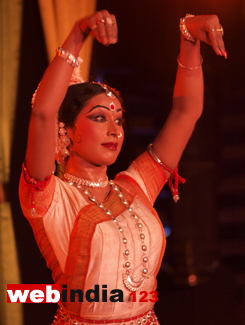|
|

|
|

| INTRODUCTION TECHNIQUE MOVEMENTS PATTERN HASTAS REPERTOIRE DANCERS |

The movement technique is developed from the basic position. There can be the possibility of walking in space, in different directions, in different manner and at different levels. The most characteristic amongst these is the semi-circular walk or the covering of space by one leg, more specifically the calf in semi circles, returning back to centre. The other half of the body is static. The same as the Minadandi i.e. covering space like a fish. There is then the manner of covering space in circles, half circles and concentric circles. This is known as ghera.
From the tribhanga position emerge another group of movement. One half of the body is kept static along the vertical median, one knee continues to be bent and the other leg is either extended to the side or to the front or to the back. It can cross the static foot at the back or the front, it can be elevated at different levels and it can be totally extended at the back with the knee bending or calf and thigh in a straight line. Through a sitting or a kneeling position another group of movements emerge. The most characteristic amongst these is the extension of one leg to the side or to the back while one foot and knee are in contact with the ground. These movements arise out of the sitting position known by the generic term baitha. Another group of movements emerge out of basic position of the chauka or the mandalasthana. Here either movement can be in place i.e. the feet can be static and only the torso can move or a complete pirouette can be executed holding the chauka position. Weight rests on the bent leg and the free leg executes a pirouette .
The Odissi technique has developed many single leg movements called the ek pada chari or using both legs or the feet called the dvipada charis and innumerable other ways of depicting the pose which can be seen in the sculptures reliefs in the Orissan temples. The dancer controls her body in the manner in which the sculpture pose is held for a spilt second only to get back into a series of movements termed. The sculpturesque quality of Odissi dance is dependent on perfect execution of these charis.
Another group of movements termed as Bhramaris are equally important. These are the spins or the pirouettes. Pirouettes can be executed in the tribhanga position or the chauka, both clockwise and anticlockwise and they can be executed in the standing position. Pirouettes also emerge from the three basic positions of the samapada, the tribhanga and the chauka. There is a simple bhramari, a bhramari with a jump therefore called an ut-pluta bhramari or an anti-clockwise pirouette called Viparita bhramari. There is also the bhramari called the antara bhramari. Here one foot touches the knee of the other leg and a pirouette is executed. The movement patterns of Odissi dance emerges from the positions, the manner of covering space and the method of executing the bhramaris.
There are then the group movements which may be called elevations, jumps or Utpluta. There is whole group of movements in Odissi dance where jumps and hopes are suggested and there is lack of contact with the ground.
There are the sculptural poses which can contained within the dance techniques. From the tribhanga can emerge many sculptural poses which have been given different names some suggesting the type of heroines i.e. nayikas, others suggesting the type of movement i.e. half bent, full bent etc and yet others suggesting an approach movement in Odissi dancing are called bhangis or sometimes the thais.